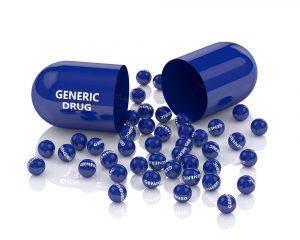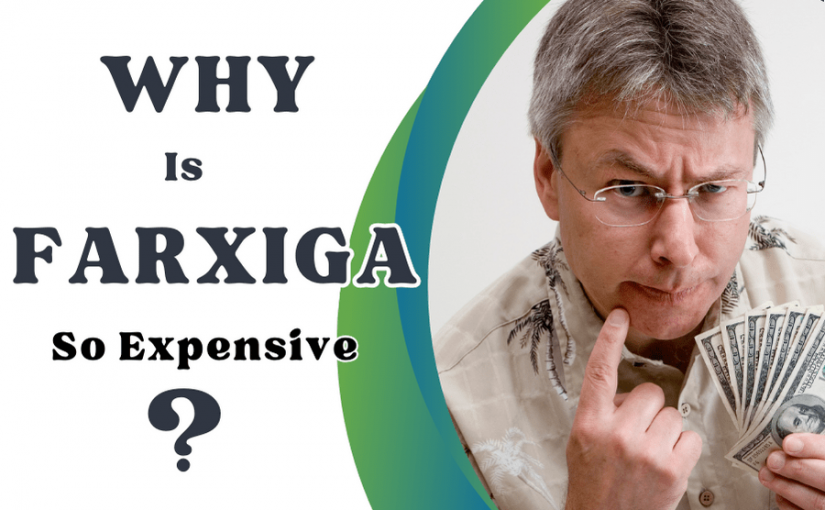Why Is Farxiga So Expensive?
Diabetes, a chronic condition that affects millions of people worldwide, demands constant vigilance and careful management. Over the years, medical science has made significant strides in developing medications to help individuals with diabetes maintain healthy blood sugar levels and reduce the risk of complications.
One such breakthrough medication is Farxiga (Dapagliflozin). In this blog, we will delve into the world of Farxiga, exploring its mechanism of action, benefits, and potential side effects, and also why is Farxiga so expensive to help better understand this promising diabetes treatment.
How does Farxiga work?

Farxiga is a medication used to treat Type 2 Diabetes Mellitus. It belongs to a class of drugs known as sodium-glucose cotransporter 2 (SGLT2) inhibitors. To understand how Farxiga works, let’s break down its mechanism of action:
- Normal Glucose Regulation: To grasp how Farxiga operates, it’s important to know how the body typically regulates blood glucose (sugar) levels. After you eat, your digestive system breaks down carbohydrates into glucose, which enters your bloodstream. To maintain healthy blood sugar levels, the kidneys play a crucial role.
- The Role of SGLT2: In the kidneys, there are tiny structures called nephrons responsible for filtering the blood and removing waste products, including excess glucose. To reabsorb glucose and prevent its loss in the urine, the nephrons use a protein called Sodium-Glucose Cotransporter 2 (SGLT2). This process is necessary to conserve glucose when it’s in short supply.
- Farxiga’s Action: Farxiga works by inhibiting the action of SGLT2. In other words, it blocks these transporters in the nephrons of the kidneys.
- Glycemic Control: By lowering blood glucose levels and promoting its excretion, Farxiga helps individuals with type 2 diabetes achieve better glycemic control. It can be used alone or in combination with other diabetes medications to help maintain target blood sugar levels.
Additionally, while Farxiga can be highly effective, it may not be suitable for everyone, and its use should be discussed with a healthcare provider who can assess its appropriateness and monitor for any potential side effects or interactions with other medications. Being a costly medicine, it raises questions like Why is Farxiga so expensive?
How much does Farxiga cost with and without insurance?

The Farxiga cost can vary significantly based on several factors, including your location, the specific pharmacy you visit, your insurance coverage, the dosage prescribed, and any available discounts or assistance programs. Here’s a general overview of what you can expect with and without insurance:
With Insurance:
- Co-Payment: If you have health insurance that covers prescription medications, your out-of-pocket cost for Farxiga will depend on your plan. Farxiga may fall into a specific tier, and you will be responsible for the copayment or coinsurance amount set by your insurance plan.
- Deductible: If your insurance plan has a deductible, you may need to meet this amount before your insurance starts covering the cost of Farxiga. Once the deductible is met, your copayment or coinsurance will apply.
- Prior Authorization: Some insurance plans require prior authorization before they will cover Farxiga. Hence, with insurance, the average monthly price can vary from $150-$200 for a 10mg dosage.
Without Insurance:
If you do not have insurance or if Farxiga is not covered by your insurance plan, you will likely be responsible for the full cost of the medication. The price of Farxiga can vary significantly from one pharmacy to another and may depend on the dosage and quantity prescribed.
The average retail price for a month’s supply of Farxiga ranged from $400 to $500 for the 10 mg dosage. However, drug prices can change over time, and they can vary widely depending on your location and the specific pharmacy you use. Hence, it is the reason why is Farxiga so expensive.
To get the most accurate and up-to-date pricing information for Farxiga, it’s advisable to surf the internet check the MedsEngage website, and pick the best option. MedsEngage provides a one-stop for medicines around the globe. Farxiga is the one. The question: Why is Farxiga So expensive can be solved by checking this e-pharm website and avail offers and discounts.
Is there a generic for Farxiga?

Yes. The generic is available. A medication for diabetes called Dapagliflozin prevents sodium-glucose transport proteins in the kidney from functioning.
By preventing over 90% of the kidney’s ability to reabsorb glucose, glucose is instead excreted in the patient’s urine, decreasing blood sugar levels. Why is Farxiga so expensive?
This can also be resolved by checking MedsEngage online pharmacy to get offers on generics as generics can be put up at lower prices.
Why Is Farxiga So Expensive?

The high cost of prescription medications like Farxiga can be attributed to several factors within the pharmaceutical and healthcare industry. Here are some of the key reasons why Farxiga and similar medications can be expensive:
- Research and Development Costs: Developing a new medication involves extensive research, clinical trials, and regulatory approvals, which can take many years and cost billions of dollars. These costs are often factored into the pricing of the drug.
- Patent Protection: When a pharmaceutical company develops a new medication, it typically receives a patent that grants exclusive rights to manufacture and sell the drug for a certain period (usually 20 years from the date of filing). During this time, the company can charge higher prices to recoup development costs and generate profits.
- Marketing and Promotion: Pharmaceutical companies invest heavily in marketing and promoting their medications to healthcare professionals and consumers. These marketing expenses are also reflected in the drug’s price.
- Limited Competition: While Farxiga was initially protected by patents, it had limited competition, which allowed the manufacturer to set a higher price. Once the patent expires, competition from generic versions often leads to lower prices.
- Production Costs: Manufacturing complex medications can be expensive, especially if they involve specialized processes or materials.
- Regulatory Costs: Pharmaceutical companies must comply with strict regulatory requirements and quality standards, which can increase the cost of manufacturing and quality control, forming the answer to the question: Why is Farxiga so expensive?
- Research and Innovation: A portion of the revenue generated from the sale of medications like Farxiga is reinvested in research and development for new and improved drugs.
- Healthcare System Structure: The structure of the healthcare system in a given country can influence drug pricing. Negotiations between pharmaceutical companies and government agencies or private insurers can result in varying prices for the same medication in different regions.
- Demand and Supply: The demand for certain medications can influence pricing. If there are limited alternatives for a specific medical condition, pharmaceutical companies may set higher prices.
- Insurance Negotiations: The price that consumers pay for medications is often negotiated between pharmaceutical manufacturers and insurance companies or pharmacy benefit managers (PBMs). These negotiations can impact the out-of-pocket costs for individuals.
It’s important to note that the high cost of prescription medications can be a source of concern for many individuals, particularly those without adequate insurance coverage or those who face high co-pays and deductibles.
In response to these concerns, there are various efforts, such as government programs, advocacy groups, and patient assistance programs, aimed at increasing access to essential medications and addressing the issue of high drug prices. Patients are encouraged to explore these options to help mitigate the financial burden of medications like Farxiga.
Endnote:
Farxiga represents a significant advancement in the treatment of type 2 diabetes. Its unique mechanism of action, coupled with its benefits in blood sugar control, weight management, blood pressure reduction, and cardiovascular and kidney protection, makes it a valuable option for many individuals with diabetes.
However, it is crucial to work closely with a healthcare provider to determine if Farxiga is the right choice for your specific medical needs and to monitor for any potential side effects.
As with any medication, Farxiga should be used as part of a comprehensive diabetes management plan that includes a healthy diet, regular exercise, and lifestyle modifications.
With the help of innovative medications like Farxiga and ongoing advancements in diabetes care, individuals with diabetes can look forward to a brighter and healthier future.
FAQs:
How rapid is weight loss with Farxiga?
According to clinical tests, those who took Farxiga by itself at doses of either 5 mg or 10 mg daily lost roughly 6 pounds in a period of 24 weeks.
How long does Farxiga stay in your system?
The body quickly absorbs a Farxiga pill after ingestion, and the drug’s maximal blood plasma concentrations are attained in just two hours.
What happens if you stop taking Farxiga?
Never stop taking dapagliflozin without first consulting your doctor. Your diabetes, heart failure, or chronic kidney disease can worsen if you stop taking it abruptly.
Can Farxiga be cut in half?
It can be cut into two halves as it comes as a tablet. However, no doctor recommends cutting the tablet for consumption.
Does Farxiga lower blood pressure?
Farxiga lowers this risk by assisting your body in eliminating extra fluid and sodium. Your blood pressure will drop as a result, which will make it simpler for your heart to circulate blood throughout your body, answering the question: Why is Farxiga so expensive?
References:
- https://www.farxiga.com/
- https://www.nhs.uk/medicines/dapagliflozin/common-questions-about-dapagliflozin/
- https://www.medicalnewstoday.com/articles/326257
- https://www.drugs.com/tips/farxiga-patient-tips

